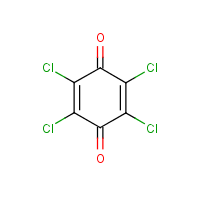Chloranil
Agent Name
Chloranil
CAS Number
118-75-2
Formula
C6-Cl4-O2
Major Category
Other Classes

Synonyms
1,4-Benzoquinone, 2,3,5,6-tetrachloro-; 2,3,5,6-Tetrachloro-1,4-benzoquinone; 2,3,5,6-Tetrachloro-2,5-cyclohexadiene-1,4-dione; 2,3,5,6-Tetrachloro-p-benzoquinone; 2,3,5,6-Tetrachlorobenzoquinone; 2,3,5,6-Tetrachloroquinone; 2,5-Cyclohexadiene-1,4-dione, 2,3,5,6-tetrachloro-; Chloranile; Coversan; Dow Seed Disinfectant No. 5; ENT 3,797; G-25804; G-444E; Geigy-444E; Geigy-444e; Khloranil; Psorisan; Quinone tetrachloride; Reranil; Spergon; Spergon I; Spergon technical; Tetrachloro-1,4-benzoquinone; Tetrachloro-p-benzoquinone; Tetrachloro-p-quinone; Tetrachlorobenzoquinone; Tetrachloroparabenzoquinone; Tetrachloroquinone; Vulklor; p-Benzoquinone, 2,3,5,6-tetrachloro-; p-Chloranil; [ChemIDplus]
Category
Aromatic Ketones, Halogenated
Description
Golden yellow solid; [Merck Index] Yellow or green powder; [MSDSonline]
Sources/Uses
Used as a dye intermediate, oxidizing agent, vulcanizing agent, dehydrogenation reagent, and veterinary topical medication; Also used as a fungicide in seed treatment and foliar application and to make chloranil electrodes for pH measurements; [HSDB]
Comments
A skin, eye, and respiratory tract irritant; May cause CNS effects with heavy exposures resulting in unconsciousness; [ICSC] A skin, mucous membrane, and respiratory tract irritant; May cause CNS depression and liver damage; [CAMEO] Symptoms of poisoning include watery diarrhea, CNS depression, coma, and death; Has caused corneal necrosis in rabbit eyes; Emergency medical treatment: see Dichlone-chloranil; [HSDB] Effects in high-dose animal studies include liver tumors, increase in cellular immune response, fatty liver degeneration, and changes in clotting factors and leukocyte count; [RTECS] See "Dichlone."
Biomedical References
Exposure Assessment
Vapor Pressure
5.1E-06 mm Hg
Lethal Concentration
LC50 (rat) = 2,485 mg/m3/4h
Adverse Effects
Neurotoxin
Other CNS neurotoxin
Hepatotoxin
Hepatoxic (a) from occupational exposure (secondary effect) or (b) in animal studies or in humans after ingestion
Diseases, Processes, and Activities Linked to This Agent
Processes
Industrial Processes with risk of exposure: